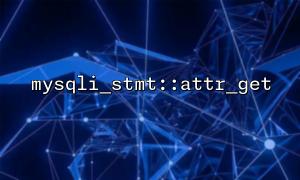When using PHP's mysqli extension for database operations, mysqli_stmt::attr_get is a relatively unpopular but practical function. It is used to get the properties of the current statement handle and is usually used to debug or diagnose underlying behavior. In order to understand the execution effect of this function more clearly, we can use debugging tools to observe its internal working process.
mysqli_stmt::attr_get(int $attribute): int|false is a method of the mysqli_stmt class. It accepts an attribute constant as a parameter and returns the current value of the corresponding attribute. If it fails, false is returned.
Common $attributes include:
MYSQLI_STMT_ATTR_UPDATE_MAX_LENGTH : Gets whether the maximum column length update is set.
MYSQLI_STMT_ATTR_CURSOR_TYPE : Gets the cursor type used by the statement.
Usually, developers pay more attention to binding parameters, execution and obtaining results when using mysqli_stmt . However, when you encounter certain performance or behavioral problems, such as result set truncation, buffering mechanism exceptions, etc., you need to deeply view the attribute status of the statement handle. At this time, attr_get is particularly important.
Xdebug is a powerful debugging tool for PHP. It can intuitively view the return value and execution path of a function with Visual Studio Code.
The steps are as follows:
Install and configure Xdebug:
zend_extension=xdebug
xdebug.mode=debug
xdebug.start_with_request=yes
xdebug.client_host=127.0.0.1
xdebug.client_port=9003
Start VS Code and configure .vscode/launch.json :
{
"version": "0.2.0",
"configurations": [
{
"name": "Listen for Xdebug",
"type": "php",
"request": "launch",
"port": 9003
}
]
}
Set breakpoints, the sample code is as follows:
$mysqli = new mysqli("localhost", "user", "pass", "database");
$stmt = $mysqli->prepare("SELECT * FROM users WHERE status = ?");
$stmt->bind_param("s", $status);
$status = 'active';
$stmt->execute();
$cursor_type = $stmt->attr_get(MYSQLI_STMT_ATTR_CURSOR_TYPE); // Set breakpoints
var_dump($cursor_type);
During debugging, the return value of $cursor_type can be clearly seen in the IDE's variable monitor.
If you cannot use the IDE or remote debugging, you can track the effect of attr_get by manually logging:
$log_file = '/var/log/mysqli_debug.log';
function log_debug($msg) {
file_put_contents($log_file, date("[Y-m-d H:i:s] ") . $msg . PHP_EOL, FILE_APPEND);
}
$mysqli = new mysqli("localhost", "user", "pass", "database");
$stmt = $mysqli->prepare("SELECT * FROM users WHERE status = ?");
$stmt->bind_param("s", $status);
$status = 'active';
$stmt->execute();
$cursor_type = $stmt->attr_get(MYSQLI_STMT_ATTR_CURSOR_TYPE);
log_debug("Cursor type: " . var_export($cursor_type, true));
You can see whether the attribute value is expected in the log, such as whether the server-side cursor is used, etc.
If further debugging is needed, for example, if you suspect that the internal mysqli extension behavior is abnormal, you can compile PHP and break points at the C implementation of mysqli_stmt_attr_get . This method is suitable for C developers and extension maintainers, and it is not recommended for ordinary developers to try it.
To be more convincing, you can build a simple test page placed at http://m66.net/debug/attr_get_demo.php , which contains a complete demo code to directly display the attribute values through var_dump and page output. In this way, even if there is no debugger, you can see the function effect intuitively.
With mysqli_stmt::attr_get , you can get the context state of statement execution more accurately during debugging. Whether it is through Xdebug debugging, log output, or viewing the underlying C code, it is an important tool for you to master database behavior. It is recommended to add these debugging techniques when tuning performance and compatibility diagnosis to improve problem positioning efficiency.














